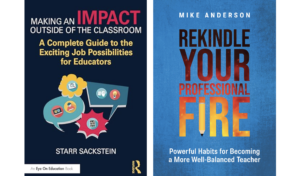Can Teachers Offer Choice in the Midst of Scripted Programs?
The Dilemma
You want to offer students choices about what they learn or how the learn it. Engagement would be higher and you could offer differentiated options to meet the needs of various learners. However, you’re saddled with a scripted program, and choice isn’t built in. (Or if it is, it’s offered as an option, if you have time—and of course you never do.)
It can feel like you have two unappealing options—to either forgo the program and risk being out of step with your school (and not teaching what your students really need) or to continue to follow the program, sheep-like, at the expense of your students’ (not to mention your own) engagement.
An Idea
There’s another possibility. What if you offered choices occasionally within the scope of the program? In this way, you’re still teaching the skills/content required of the program but also still infusing some creativity and differentiation into the mix. You might be wondering: Is this okay? Will my principal (or assistant superintendent or curriculum director) let me do this? In my experience, administrators don’t want teachers and kids held back by programs either, and they often want teachers to use their professional judgment to enhance what we’re handed. (I’ve never heard of a teacher who was fired for making learning better for kids.) Of course, you can always ask if you’re worried. Or, you can simply follow the old adage that it’s sometimes better to beg for forgiveness than ask for permission.
One Example
Third grade teachers at Fuller School in Keene, NH recently decided to tackle this challenge, and they gave me permission to share what they came up with. Keep in mind that what you’re about to explore is a work in-progress. We came up with these ideas during a one-hour meeting in the middle of a busy school day.
Program/Unit: Fundations, Unit 4 (suffixes, exceptions to vce words, review for r-controlled vowels, r-controlled vowel teams, and sound-alike words)
Rationale for Offering Choice: The goal is to create some activities students could choose from to work on independently while the teacher gives the more structured lesson to the rest of the group. In this way, they can give more individual attention to students as they teach and offer differentiated options to students as they work independently.
Possible Choices for Independent Work:
- Use sort cards to find exceptions (record on recording sheet)*!
- Give students the words to sort*!
- Blank cards—they could create their own*!
- Scavenger hunt for suffixes (6 common ones on p. 170)*!
- Sort vowel and consonant suffixes (use ones from scavenger hunt)*!
- Partner activity: use word tiles to spell words*
- Graphing words (like crosswords)*
- Banagrams, Scrabble tiles—to create words*!
- Students create word-searches
- Create word sorts of review words*!
- Memory game—using review words or suffix words*!
- Give Boggle boards with suffixes embedded*!
- Complete a 3-columned chart (base word, past tense, present tense)*!
- Scavenger hunt—three different sounds “ed” suffix makes*!
- Pop-Fizz-Buzz*!
Key:
* most likely kids can do independently—without adult support
! high-impact—time well spent
Further Explanation:
First we brainstormed the ideas you see in the list. Then we briefly reviewed them to decide which activities would require minimal teacher support (*) and which seemed to offer the best actual practice with skills (!). Teachers decided that they would begin by trying just a couple of choices as a time, each using ideas that they thought would fit their students and their own comfort level.
The Process
If you want to try this same process, here are some steps to get you started:
- Identify why you want to offer choice. Is it to offer differentiated options? Is it to boost engagement? Is it to support management?
- Be clear about the academic goals you’re working on. Make sure you generate choices that support the learning objectives of the program/curricula you’re using.
- Generate a bunch of possible ideas—don’t judge the ideas as you’re brainstorming.
- Once you have a list of choices, consider which ones are best. Which ones most closely connect with learning goals? Which ones will be engaging for students? Which ones are manageable for you to implement?
- Use the Choose–Do–Review structure (outlined in Learning to Choose, Choosing to Learn) to plan the choice experience for students.
- Give it a try and reflect. How did it go? What worked and what was challenging?
A Final Thought
In my 25+ years as an educator in the United States, the move to scripted/boxed programs has been one of the most deprofessionalizing changes I’ve seen. The activity outlined here is one way we can try to reclaim some of our autonomy and creativity as teachers so that our students’ school experiences aren’t defined and limited by these programs.
To explore many more resources about the effective implementation of choice (in all content areas and in K-12 settings), check out this LiveBinder.




